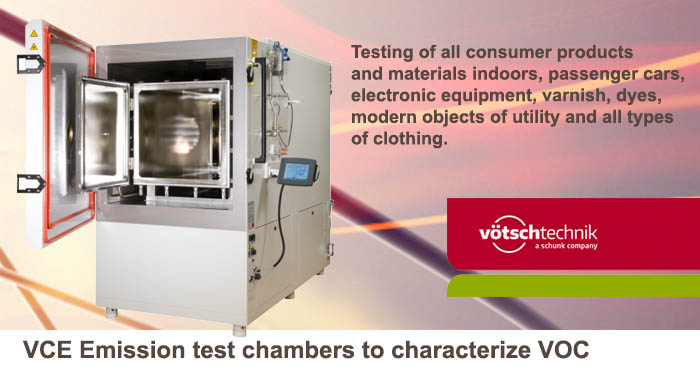VCE Emission test chambers to characterize volatile organic compounds (VOC)
The relevant factors and their effect on the emission behavior of materials in connection with suitable measuring methods can be used to evaluate emission together with the Vötsch chamber.

Environmental test equipment to characterize ...
Materials can be affected by environmental influences. However, under these influences, the materials can be harmful to the environment also, e.g. by emissions from the materials into the air.
These emissions are particularly relevant in closed rooms. They can affect other available materials and of course also human beings.
The relevant factors and their effect on the emission behavior of materials in connection with suitable measuring methods can be used to evaluate emission together with the Vötsch Technik chamber.
Analytical investigations, system calibration and olfactometer studies are possible with suitable measuring equipment.
Volatile organic compounds (VOC) from indoor materials and products are determined under practical conditions.
Scientific measurement and product testing aimed to limit organic emissions indoors, for the purpose of improved consumer protection, can be evaluated.
Exposure to indoor air pollution caused by volatile organic compounds (VOC) must be further reduced resp. indoor air quality improved - for several reasons:
- An increased use of polymer hydrocarbon compounds in indoor materials and products results in a growing number of emitting sources
- Energy saving insulation reduces the ventilation rates in buildings which leads to an accumulation of pollutants indoors
- Reduction of the environmental pollution of technical devices (greenhouse effect, ozone layer depletion)
- Increased sensibility of the human organism to the influence of minute concentrations
- Modern people spend about 90% of their time indoors
Requirements / fulfilment
The technical requirements of the environmental test equipment were defined by specialists from industry and science and then successfully put into practice:
- A test equipment with a low emission (purity in molecular range)
- Excluding contaminations from the vicinity
- Particle measurement
- Minimizing adsorption effects
- High desorption temperatures ( > 200°C)
- High parameter accuracy
- Ventilation
- Tests with and without air exchange
- Standard analytical equipment can be used
- Networking
Two emission test chambers with standard test space sizes of 200 and 1000 liters are available. An ideal practically oriented solution. Special sizes on request.
Features
- Test space stainless steel, electro polished and pressure proof to ±10mbar
- Air-jacket conditioning
- Carrier gas conditioning for climate
- Carrier gas massflow control via massflow controller
- Desorption and rinsing procedure
- Special ventilation with a dry mounted magnetic clutch
- Connection for discharging quantities of gas for analysis
- Entry port septum
- Water storage container (humidification water) of stainless steel with automatic water replenishment
- Microprocessor control and monitoring system
- Colour touch panel
Application
- Testing of all consumer products and materials indoors
- Passenger cars
- Electronic equipment
- Varnish
- Dyes
- Modern objects of utility
- All types of clothing










